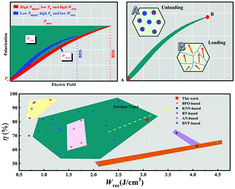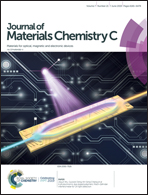Enhanced energy storage properties in sodium bismuth titanate-based ceramics for dielectric capacitor applications†
Abstract
There are imperious demands for developing eco-benign energy storage materials with high-performance in a sustainable society. In this paper, we introduce Sr0.85Bi0.1□0.05TiO3 (SBT) and NaNbO3 (NN) into Bi0.5Na0.5TiO3 (BNT) ceramics through compositional design. The introduction of Sr2+ ions and vacancies at the A-sites constructs relaxor ferroelectrics according to order–disorder theory. The introduction of Nb5+ ions at the B-sites is confirmed to have two major implications. In one way, it boosts a higher induced polarization due to its intrinsic larger polarizability and overall stronger degree of diffuseness. In another, it contributes to forming a core–shell microstructure, as proven using transmission electron microscopy, promoting the breakdown strength (BDS) to a higher level. With the above strategies, our BNT–SBT–4NN ceramics demonstrate excellent energy storage performances with simultaneously ultrahigh energy storage density (W ∼ 3.78 J cm−3), recoverable energy storage density (Wrec ∼ 3.08 J cm−3) and efficiency (81.4%). Furthermore, the ceramics possess excellent discharge energy density (Wd = 0.854 J cm−3) and rapid discharge speed (t0.9 ∼ 100 ns) in a wide temperature range, proving their high application potential. Our results break through the bottleneck of BNT-based ferroelectrics with a general recoverable energy storage density of lower than 3 J cm−3, making the BNT–SBT–4NN ceramic a powerful candidate material for use in energy storage applications.

- This article is part of the themed collection: 2019 Journal of Materials Chemistry C Most Popular Articles


 Please wait while we load your content...
Please wait while we load your content...